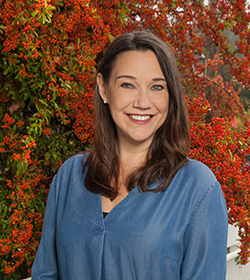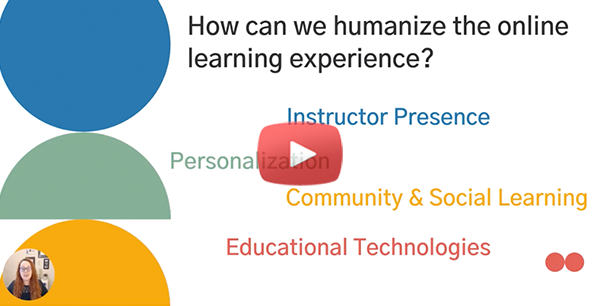Bringing TOPkit Digest to You
|
|
|
The content in this month’s TOPkit Digest is brought to you by a collaboration between Melissa Jones, M.A., Instructional Systems and Learning Technologies, Florida State University (mkjones@fsu.edu) and Carla M. Nevarez, MBA, MSET, Assistant Instructional Designer, Center for Distributed Learning, University of Central Florida (carla.nevarez@ucf.edu) who discuss the topic of humanizing the remote learning experience.
|
|
Contents of this Digest:
- Video Tip: Humanizing the Remote Learning Space
- Top Tips: Moving Towards a Humanized Online Learning Experience
- Must-Read Announcements: Hackathon, TOPkit Workshop, Innovation Summit
- From the Community: How and Why to Humanize Online Learning
- Top Community Topics
|
|
Humanizing the Remote Learning Space
A Special Focus on Faculty Development |
|
|
|
Melissa Jones, M.A., and Carla Nevarez, MBA, MSET, provide an overview of how we can situate faculty development offerings into conversations about humanizing online learning. |
|
MUST-READ ANNOUNCEMENTS
- Join us to improve upon or build a new artifact useful for faculty development work at our TOPkit Fall Hackathon 2021. The kickoff is on November 1 and the sendoff is on November 8. Colleagues plan, build, and briefly showcase their resulting efforts.
- Take part in the live, virtual Florida Innovation Summit 2022, February 23-24.
- Join us for the live, virtual TOPkit Workshop 2022, March 1-3.
- Download a sample course, now available in Spanish, to use as a workshop for faculty teaching online or blended courses.
|
|
Moving Towards a Humanized Online Learning Experience
Expanding the Conversation to Include Faculty Development |
|
|
|
As faculty developers and instructional designers, we often work at the intersection of multiple realms. Our practices are rooted in evidence-informed pedagogy, supported by research on the most innovative technologies, and carefully developed with an awareness of project management and design thinking. It is through these practices that we are able to support faculty who wish to create powerful learning experiences for their students. One of the ways that we can support teaching faculty who are building courses, especially in online environments, is to offer them ideas and suggestions for humanizing the remote learning experience. While there is no shortage of conversations happening around the concept of humanizing online learning for students, due in large part to the incredible work of Michelle Pacansky-Brock, we rarely discuss the ways that we, as faculty developers, humanize the training, development, and support that we offer our learners: the faculty. In this TOPkit Digest, we reflect on our own design and delivery methods and explore ways to apply the best practices in humanizing online learning to faculty development offerings.
|
|
|
|
|
|
|
|
|
#1 - Model Relevant Design Practices: Many of the practices and principles of design that we know to be beneficial to student learners, may also be used to humanize the experiences of remote faculty development. Consider, for example, Merrill’s First Principles of Instruction. If applied to online professional development, we would ask faculty to focus first on solving the problems they face as educators and then apply and integrate what they have learned. Additionally, other models and frameworks, like Keller’s ARCS model and the Community of Inquiry framework, are both options that may work especially well when designing for faculty audiences. Adopting these practices will help to support more humanized, and more personalized, learning experiences.
|
|
#2 - Make it Meaningful: Regardless of the type of remote professional development offering, one way to humanize the experience is to provide faculty with opportunities to be active in the co-construction the content. This practice of co-creation allows for more authentic and meaningful interactions. Educational development is ultimately about helping faculty grow as educators, so relying on constructivist approaches and offering professional development with a focus on authentic learning makes the overall experience more meaningful. When facilitating professional development offerings, designers should provide faculty with a platform to explore the content, expand upon the shared knowledge, and implement the practices. To add even greater value, allow faculty the opportunity to reflect on their experiences.
|
|
#3 - Be Proactive and Responsive: When working with faculty, especially when delivering content through the LMS or a training platform, it is tempting to assume that interactions and feedback can be minimal, or in cases of self-paced courses, non-existent. However, just like student learners, faculty benefit from instructor presence. With faculty development opportunities, facilitators should model the best behaviors and strategies for establishing connections and should be both proactive and responsive. Consider including personalized welcome messages, details about the facilitator, and clear goals for the course, with scheduled check-ins and feedback. Even in self-paced courses, build in opportunities for connecting with facilitators and work to personalize automated feedback. | |
#4 - Build Diverse and Inclusive Learning Communities: It is important to realize that remote faculty development does not always equal formal, prescriptive trainings. There are numerous ways to support professional development, and often for designers and developers, some of the most effective practices center around creating diverse and inclusive learning communities. Through participation in these communities, faculty feel a sense of belonging and stronger connections to their colleagues and their purpose. Cohort models work especially well for creating more social connections among colleagues, whereas more specialized groups such as Faculty Learning Communities and Faculty Reading Groups, like those at FSU and FIU, are great ways to foster connections over shared interests. When focusing on bringing together diverse groups, unique practices in cross-disciplinary collaborations, like UCF’s Teaching Squares, and cross-departmental events that include faculty, IT teams, Student Affairs, and Accessibility Services, for example, are additional ways to humanize remote learning spaces. As different members of the university bring their own perspectives, there is a shared sense of institutional community and collegial connection that extends far beyond the individual experience.
|
|
#5 - Use Technology to Bring Learners Together: Although it may seem counterintuitive to rely on technology to create more humanized learning spaces, advances in educational technologies have given us the ability to form connections in remarkable ways. Much like the work we do with student audiences, we can adopt many of the same tools to work with our faculty learners. Video capabilities through tools like Flipgrid, Teams, and Zoom let us connect with colleagues who are remote or spread across multiple campuses, and when working with asynchronous professional development courses, many of the popular learning management systems, like Canvas and D2L, have video posting and feedback built right into the platform. We have also seen great advances in collaborative virtual workspaces that can be especially useful for working with faculty on projects. Miro, Padlet, and many of the Microsoft and Google tools have been designed to create more human-centered virtual collaboration.
|
|
How and Why to Humanize Online Learning
Michelle Pacansky-Brock - TOPkit Workshop 2020 Keynote |
|
|
|
| |
 |
Pacansky-Brock's work has helped online instructors across the nation understand how to craft relevant, humanized online learning experiences that support the diverse needs of college students. In her current role as Faculty Mentor for the California Community Colleges, she coordinates professional development in support of quality online teaching and learning and is leading a $1.3 million California Learning Lab grant project that will examine the impact of humanized online instruction on diverse students in undergraduate online STEM courses in California.
|
|
References and Works Consulted
|
|
|
Brightspace D2L. (n.d.). Create a video note attachment [Brightspace Help]. https://documentation.brightspace.com/EN/le/video_note/learner/
create_video_note_attachment.htm Center for Teaching Excellence. (n.d.). Faculty learning communities. Miami University. http://miamioh.edu/cte/faculty-staff/flcs/index.html Center for the Advancement of Teaching. (n.d.). Faculty reading groups. Florida International University. https://cat.fiu.edu/programming/book-groups/ Center for the Advancement of Teaching. (n.d.). Faculty reading groups: 2021 fall reading groups. Florida State University. https://teaching.fsu.edu/faculty-reading-groups/ Digital Learning. (2020). Humanizing online learning [Video]. University of Central Florida. YouTube. https://www.youtube.com/watch?v=fe_7Fuim7Fw&t=181s Faculty Center for Teaching and Learning. (2021, September 30). Faculty development cohorts. University of Central Florida. https://fctl.ucf.edu/programs/faculty-development-cohorts/ Faculty Center for Teaching and Learning. (2021, August 27). Teaching squares. University of Central Florida. https://fctl.ucf.edu/programs/teaching-squares/ Flipgrid. (n.d.). Getting started. https://blog.flipgrid.com/gettingstarted Haave, N. (2018, July 13). Teaching squares: A teaching development tool. Faculty Focus | Higher Ed Teaching & Learning. https://www.facultyfocus.com/articles/faculty-development/teaching-squares-cross-disciplinary-perspectives/
Haras, C. (2020, April 29). Faculty development as an authentic professional practice. Higher Education Today. https://www.higheredtoday.org/2018/01/17/faculty-development-authentic-professional-practice/ Huang, W., Hurt, A., Richardson, J. C., Swan, K., & Caskurlu, S. (2020). Community of Inquiry framework. Purdue University. https://www.purdue.edu/innovativelearning/supporting-instruction/
portal/files/4_Community_of_Inquiry_Framework.pdf Instructure Community. (2021, September 29). How do I leave feedback comments for student submissions in SpeedGrader? https://community.canvaslms.com/t5/Instructor-Guide/How-do-I-leave-feedback-comments-for-student-submissions-in/ta-p/764 Microsoft Education. (n.d.). Microsoft Teams: Online & remote classroom. https://www.microsoft.com/en-us/education/products/teams Office of Curriculum, Assessment and Teaching Transformation. (2021, September 29). Constructivism. University at Buffalo. https://www.buffalo.edu/catt/develop/theory/constructivism.html Pacansky-Brock, M. (n.d.). Behaviors & strategies for improving your instructor presence. Teaching Without Walls. http://page.teachingwithoutwalls.com/instructorpresencestrategiesci Pacansky-Brock, M. (2020, March 24). Humanizing online learning. https://brocansky.com/humanizing-online-learning Pappas, C. (2015, May 20). Instructional design models and theories: Keller's ARCS Model of Motivation. eLearning Industry. https://elearningindustry.com/arcs-model-of-motivation Teaching Commons. (n.d.). The importance of instructor presence in online learning. University of North Texas. https://teachingcommons.unt.edu/teaching-essentials/online-teaching/importance-instructor-presence-online-learning
|
|
Developer and Editor
Bren Bedford, MNM, Web Project Analyst, Center for Distributed Learning, University of Central Florida
Editor
Samantha Richardson, B.A. English, Communications Specialist, Pegasus Innovation Lab, Center for Distributed Learning, University of Central Florida
|
|
|



